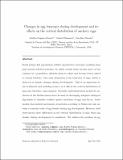Por favor, use este identificador para citar o enlazar a este item:
http://hdl.handle.net/10261/48701COMPARTIR / EXPORTAR:
 SHARE SHARE
 CORE
BASE CORE
BASE
|
|
| Visualizar otros formatos: MARC | Dublin Core | RDF | ORE | MODS | METS | DIDL | DATACITE | |

| Título: | Changes in egg buoyancy during development and its effects on the vertical distribution of anchovy eggs |
Autor: | Ospina-Álvarez, Andrés CSIC ORCID ; Palomera, Isabel CSIC ORCID ; Parada, Carolina | Palabras clave: | European anchovy Egg buoyancy Egg density Vertical distribution Individual based model IBM CUFES |
Fecha de publicación: | abr-2012 | Editor: | Elsevier | Citación: | Fisheries Research 117-118: 86-95 (2011) | Resumen: | Small pelagic fish populations exhibit reproductive strategies resulting from past natural selection pressure, by which certain traits become more or less common in a population, allowing them to adapt and become better suited to certain habitats. One such adaptation is the buoyancy of eggs, which is observed as density changes during development. This is an important issue in fisheries and modeling science, as it affects the vertical distribution of eggs and, therefore, egg transport. Recently, individual-based models for anchovies in the Mediterranean have focused on developing adequate biological algorithms to simulate realistic spatial variations of eggs and larvae. Some models that include movements of particles according to Stokes’ law also assume a constant value of egg density during egg development. However, field observations show differences in the vertical distribution of eggs when egg density during development is considered. We address the problem of egg density and its vertical distribution within a biological context. In Mediterranean waters, the incubation time for anchovy eggs during peak spawning is approximately 48–70 h; during these first hours, egg density has an influence on the horizontal and vertical trajectories of eggs, as well as their routes and hatching zones. In this study, we introduce an algorithm describing the egg density of European anchovy eggs throughout development. Egg density measurements were carried out in a density gradient column (DGC). We fitted a polynomial model that estimated egg density, as a function of time from fertilization and that was dependent on temperature. Simulations to study the vertical transport of eggs in the Mediterranean were carried out using ICHTHYOP/MARS3D. The vertical distribution of pelagic eggs was determined by a set of interacting biological and physical parameters related to eggs (density, diameter) and ambient seawater (density, viscosity, turbulence), respectively. The egg buoyancy model introduced here was validated and will provide insight for the design of anchovy egg surveys, as the vertical position of the eggs in the water column during development can be inferred by the hydrographic structure of seawater | Descripción: | Special issue Egg Production Methods in Marine Fisheries.-- 10 pages, 7 figures, 1 table | Versión del editor: | https://doi.org/10.1016/j.fishres.2011.01.030 | URI: | http://hdl.handle.net/10261/48701 | DOI: | 10.1016/j.fishres.2011.01.030 | ISSN: | 0165-7836 |
| Aparece en las colecciones: | (ICM) Artículos |
Ficheros en este ítem:
| Fichero | Descripción | Tamaño | Formato | |
|---|---|---|---|---|
| Ospina_et_al_2012_ postprint.pdf | 1,75 MB | Adobe PDF |  Visualizar/Abrir |
CORE Recommender
SCOPUSTM
Citations
50
checked on 18-abr-2024
WEB OF SCIENCETM
Citations
45
checked on 19-feb-2024
Page view(s)
740
checked on 23-abr-2024
Download(s)
421
checked on 23-abr-2024
Google ScholarTM
Check
Altmetric
Altmetric
NOTA: Los ítems de Digital.CSIC están protegidos por copyright, con todos los derechos reservados, a menos que se indique lo contrario.
